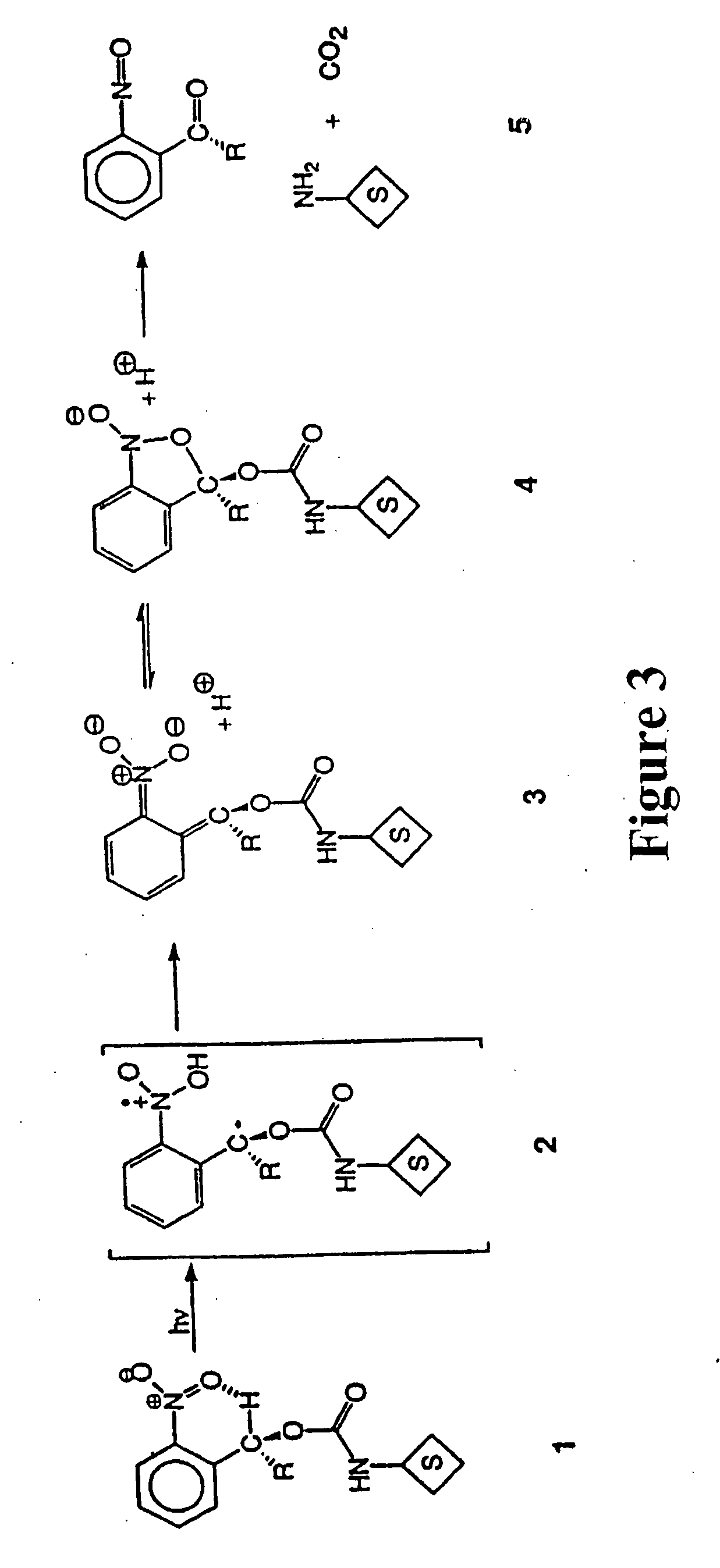Photocleavable isotope-coded affinity tags
a technology of affinity tags and isotopes, applied in the field of photocleavage isotope-coded affinity tags, can solve the problems of inability to quantify analysis, incompatible with low-abundance protein analysis, and inability to indicate changes in protein expression, so as to simplify analysis and eliminate variability.
- Summary
- Abstract
- Description
- Claims
- Application Information
AI Technical Summary
Benefits of technology
Problems solved by technology
Method used
Image
Examples
example 1
[0314] Photocleavable Biotin NHS carbonate (see, FIG. 12). This example shows the synthesis of a photocleavable Biotin NHS carbonate. 5-methyl-2-nitrobenzoic acid (1) (5 g; 27.6 mmol) was added in small portions to thionyl chloride (16.4 g; 138 mmol). After 10 hrs of stirring at room temperature excess of thionyl chloride was evaporated to give the acid chloride (2). Magnesium turnings (1.07 g; 44.2 mmol), absolute ethanol (6 ml), chlorobenzene (8 ml) and 0.1 mg of dry CCL4 were refluxed for 2 hrs. Diethyl malonate (4.82 g; 30 mmol in 10 ml of chlorobenzene) was added, followed by the addition of the acid chloride (2) (5.49 g; 27.5 mmol in 10 ml chlorobenzene). The reaction mixture was stirred for 1 hr, acidified with 20 ml of 2N sulfuric acid, extracted with chloroform (3×20 ml), dried and evaporated to dryness. The residue was dissolved in acetic acid (8.25 ml), 5.4 ml of H2O and 1 ml of concentrated H2SO4 were added and the mixture was refluxed for 6 hrs. The reaction mixture was...
example 2
[0317] Water soluble PC-Biotin synthesis (see, FIG. 13). The example shows the synthesis of a water soluble PC-Biotin. 5-aminomethyl-2-nitroacctophenoe hydrochloride (1.73 g, 7.5 mmol) (FIG. 13, compound 1) was dissolved in 60 ml DMF. To this solution was added DIPEA (N,N,-diisopropylethylamine) (1.2 ml) DMAP (dimethylaminopyridine ) (0.46 g; 3.75 mmol) and succinic anhydride (0.75 g, 7.5 mmol). The reaction was stirred at room temperature overnight, added to 120 ml of 0.1 N HCl and extracted with 3×50 ml chloroform. Organic extracts were combined, dried and evaporated. Crude product was recrystallized from acetonitrile to give compound 2 (1.2 g, 49% yield).
[0318] To a stirred solution of 2,2′-(ethylenedioxy)-bis-(ethylamine) 3 (2 g; 13.5 mmol) in 100 ml of acetonitrile a solution of Fmoc-NHS (9-fluorenylmethyloxycarbonyl-NHS) (4.95 g, 14.8 mmol) in 50 ml acetonitrile was added during 30 minutes. The reaction mixture was stirred for additional 1 hr, concentrated under reduced press...
example 3
α-Fmoc, ε-PC-Biotin-Lys(U—12C6,14N2)—OH (compound 3, FIG. 14A)
[0323] This example shows the synthesis of an α-Fmoc, ε-PC-Biotin-Lys-OH. α-Fmoc, ε-tBoc-Lys-OH (Novabiochem, San Diego, Calif.) (12 mg, 25.16 mmols) (FIG. 14A, compound 1) was treated with 200 μl of a 50% TFA (trifluoroacetic acid) solution in methyl chloride at room temperature for 20 minutes. The volatile components of the mixture were then removed under temperature for 20 minutes. The volatile components of the mixture were then removed under reduced pressure and the mixture was co-evaporated with toluene (3×500 μl). The product was finally freeze-dried from acetonitrile and then dissolved in 200 μl of DMF. To this solution a solution of PC-Biotin (20 mg, 1 eq., 25 μmoles) was added in 200 μl of DMF followed by 2 eqs. Of N,N-diisopropylethylamine (50 μmoles, 9 μl). After stirring for 2 hrs at room temperature, the mixture was acidified to pH=2 by the addition of 1N HCl and extracted with chloroform (5×300 μl). The ch...
PUM
| Property | Measurement | Unit |
|---|---|---|
| Force | aaaaa | aaaaa |
| Digital information | aaaaa | aaaaa |
| Length | aaaaa | aaaaa |
Abstract
Description
Claims
Application Information
 Login to View More
Login to View More - R&D
- Intellectual Property
- Life Sciences
- Materials
- Tech Scout
- Unparalleled Data Quality
- Higher Quality Content
- 60% Fewer Hallucinations
Browse by: Latest US Patents, China's latest patents, Technical Efficacy Thesaurus, Application Domain, Technology Topic, Popular Technical Reports.
© 2025 PatSnap. All rights reserved.Legal|Privacy policy|Modern Slavery Act Transparency Statement|Sitemap|About US| Contact US: help@patsnap.com



